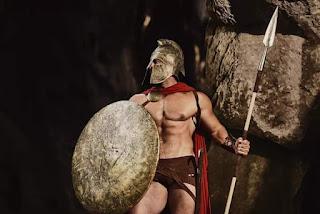"Come and take them." David vs Goliath
"Come and take them." David vs Goliath
One of the greatest David vs. Goliath tales of history is the battle of Thermopylae, when 300 Spartans held off a huge Persian army. Of these 300, 299 perished; a lone survivor took the story back to his people.
Many of us have seen the film 300, but how authentic is the red-cloak-wearing-six-pack-filled movie?
Well, for a start, there weren't just 300, and they weren't all Spartans.
There is thought to have been at least 4,000 soldiers on the first two days and around 1,500 men involved in the epic last stand.
Even if, as has been suggested, the vastness of the Persian army has been exaggerated, the above numbers of those who fought against them still pales in comparison.
The Persian king Xerxes had at the most an army that was 100,000 strong, although it was much likely smaller. In 480 BCE, he invaded Greece with the intention of subduing the city-states and adding them to his far-reaching empire.
He was relying on the Greeks’ internal squabbling to make them an easy target, but they rallied together, putting aside their differences, and forming a united front.
The place chosen to check the Persian advance was the land pass of Thermopylae; it was forty miles away from a narrow strait between the mainland and Euboea, and it was already fortified against invasions. It was thought a smaller Greek force could block the advance of the Persian armies and fleet and protect Greece.
The Spartans, who were a brutal yet highly skilled militaristic people, agreed to defend Thermopylae. This agreement was made early in the campaign, but by the time it came to dispatch the force, it was August.
This month was a bad time for Sparta; they were obligated to hold both their Olympics and Carneia that month. These were held in honour of the gods, something the Spartans were zealous about, and to postpone or cancel them could risk offending the gods.
To keep their divine favour, they compromised, sending a small army of 300 advanced guards led by King Leonidas instead of his 300-strong bodyguard unit of the best young men. So Leonidas departed with 300 veterans to defend the pass.
Other states sent men to support the Spartan 300; among them, 700 men came from Thespiae and 400 from Thebes. The Spartans also brought 300 enslaved people to assist in their war effort.
The predictions were correct; the Persians did arrive at Thermopylae. They offered peace in return for surrender, which was refused, and the attack began on the fifth day.
For 48 hours, the defenders of Thermopylae held their position, defeating all the units sent their way from the poorly trained levies to the Immortals, the Persian elite.
Unfortunately for the Greeks, Thermopylae held a small pass of little defence, which if crossed could allow their enemy to outflank them. It was this path that the Immortals followed, brushing aside the small guard and preparing to catch the Greeks from behind.
Unwilling to sacrifice the entire army but determined to keep his word to defend Thermopylae, Leonidas ordered everyone but his Spartans and their slaves to retreat. The Thebans and Thespians stayed (there are conflicting reports as to whether this was by choice or not). When the hostilities resumed, there were 1500 Greeks left, including 298 Spartans.
Caught between the main Persian army and the 10,000 men to their rear, everyone was wiped out, except for the Thebans, who surrendered.
Over the years, the stand at Thermopylae has become legend, and while indeed myth has entwined with reality, regardless of how many men were there to begin with or how many actually fought in the defence of Thermopylae, it still remains a fantastic mix of history and myth.
Sources:
Persian Fire, Tom Holland (the historian not Spiderman)
Thermopylae: The Battle for the West, Ernle Bradford
The Greco-Persian Wars, Peter Green
The Defense of Greece, J. F. Lazenby
The Battle of Thermopylae: A Campaign in Context, Robert Oliver Matthews











Comments
Post a Comment